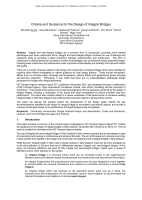Bridges

- Publication no: ABC2017-103-17
- Published: 26 April 2017
- PDF (free) Download
Integral and semi-integral bridges are a common form of construction, providing some marked advantages over other construction forms. Integral and semi-integral bridges minimise the use of bearings and expansion joints by providing a direct connection between superstructure and substructure. This form of construction is often preferred as it provides a number of advantages over conventional simply supported bridges, including lower construction and maintenance costs, improved constructability and durability and improved vehicle ride quality.
There are a number of issues related to the design and construction of integral bridges which were identified as requiring either further investigation or clearer guidance for local design practice. These include non-seismic effects such as concrete creep, shrinkage and temperature, seismic effects and geotechnical issues including soil–structure interaction. Particularly, it was noted that there are no well-established earthquake design procedures for bridges with integral abutments.
NZ Transport Agency research report 577, published in November 2015, was developed through a collaboration of NZ Transport Agency, Opus International Consultants Limited, John Wood Consulting and the University of Canterbury. The purpose of the guide is to provide local engineers with the necessary guidance for the design of integral bridges, including a description of the issues that need consideration to ensure excellent long term performance. The report also contains details of a review undertaken of the performance of numerous existing integral bridges in both New Zealand and California that have been subject to strong seismic events.
The paper will discuss the process behind the development of the design guide, identify the key recommendations identified for the design of integral bridges in non-seismic and seismic regions, and provide a summary of learnings based on the performance of integral bridges locally and globally.
* Best Young Author Paper Winner Austroads Bridge Conference 2017
